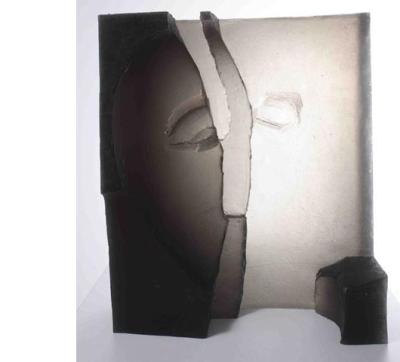 Ann Wolff, lost blues, 2007. Kiln casted glass. H 23, W 19 1/4, D 6 1/4 in. courtesy: the artist
Ann Wolff, lost blues, 2007. Kiln casted glass. H 23, W 19 1/4, D 6 1/4 in. courtesy: the artist
Just six months after receiving the Glass Art Society‘s Lifetime Achievement Award, artist Ann Wolff was honored with another prestigious accolade, the PRO EUROPA Foundation’s European Culture Prize on December 12th. She is the first Swede to collect this honor in recognition of her contributions to the art world in kiln-cast glass sculpture and her prominent role in the beginning of the Studio Glass movement in Europe.
 Ann Wolff with fellow award recipient Jean-Claude Juncker (at right) and Jean-Claude Trichet, former President of the European Central Bank.
Ann Wolff with fellow award recipient Jean-Claude Juncker (at right) and Jean-Claude Trichet, former President of the European Central Bank.
At irregular intervals throughout the year, the European Culture Prize is awarded to forward-thinking individuals whose body of work represents the vision of Europe that the PRO EUROPA Foundation supports. Ann Wolff has been heralded as an artist with a propensity for exposing the subtleties of the human condition. Much of her work — drawings and glass sculpture included — are abstract representations of human faces, busts, and bodies, often intertwined and overlapping and set against simple lines and monochromatic tones. She frequently employs both the negative and positive mold of the cast in the same piece, expressing a Hamlet-worthy internal struggle. Her multi-layered glass sculptures, as in Waltz (2010), evoke an essence of the quiet, dusty aftermath of catastrophe, and her series of lone faces maintain an expression of stern determination.
A recent article written by Martina Windels in the Winter 2010 – 11 edition of GLASS: The UrbanGlass Art Quarterly (#121) explored the subtle transformations of Wolff’s decades-long artistic career. With an artistic trajectory beginning with drawings, Wolff’s career is described by Windels as “contemplative,” her work morphing into deeply layered sculptures with “lines [that are] freer and more painterly.” Moving from stark, yet purposefully imperfect, geometric forays into glass sculpture, Wolff’s more recent works, such as Mother Andante (2006) and Light In (2005) accurately convey gesture, breath and movement.
“As in dance, a gesture is the expression of emotion without words, and Wolff, whose lines have been strong gestures all along, has found a way to translate this into glass,” writes Windels. Wolff has garnered much of her inspiration from dance, having sat in on dance-theatre artist Pina Bausch’s rehearsals and used the sketches of the extreme, whirlwind movement vocabulary for which Bausch is famous as blueprints for certain glass sculptures. Her “LIVE” exhibition, now on view at Galerie B, a German glass gallery where her work will be view through February 29, 2012), is comprised almost entirely of musings on the human form and its various modes of expression.
Wolff’s work is a striking representation of the struggle for peace and balance over the course of a lifetime — or several lifetimes. Outsiders tend to view Sweden as a relatively unshakable nation made up of highly focused, well-balanced individuals. Ann Wolff provides an insider’s view of this near-perfect nation in Northern Europe, wrought with as ripe an emotionality as those cultures who wear their economic and political woes on their collective sleeves. For an organization dedicated to bringing together artists and entrepreneurs from a collection of countries whose borders have changed drastically over the course of human history, she seems to more than fit the bill.
-Katharine Morales


